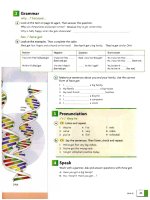economic english 5 doc
Bạn đang xem bản rút gọn của tài liệu. Xem và tải ngay bản đầy đủ của tài liệu tại đây (102.35 KB, 6 trang )
Problem-solving questions will ask you to apply your
understanding of information presented as part of the
question. Questions of this type could require you to:
■
interpret results
■
draw conclusions based on results
■
analyze experimental flaws or logical fallacies in
arguments
■
make a prediction based on information pro-
vided in the question
■
select the best procedure or method to accom-
plish a scientific goal
■
select a diagram that best illustrates a principle
■
apply scientific knowledge to everyday life
■
use the work of renowned scientists to explain
everyday global issues
Some questions will require you to draw on knowl-
edge you have acquired through your daily life and prior
schooling. In other questions, all the necessary informa-
tion will be included in the passage or graphic provided
as part of the question. In either case, reviewing basic sci-
ence concepts presented in the following chapters and
answering as many practice questions as you can will
improve your performance.
About half the problems on the GED Science Exam
will require you to understand, interpret, or apply infor-
mation presented in graphical form. Graphical informa-
tion includes diagrams, charts, and graphs. Graphics are
a concise and organized way of presenting information.
Once you realize that all graphics have some common
basic elements, it will not matter whether their informa-
tion presented is in the area of biology, chemistry,
physics, or Earth science.
DIAGRAMS
Diagrams can be used to show a sequence of events, a
chemical or biological process, the setup of a science
experiment, a phenomenon, the relationship between
different events or species, and so forth. Here are some
examples that you can look up in your science textbooks:
■
diagram of an electrochemical cell (physical
science)—process
■
diagram of the phases of cell division (life
science)—sequence of events
■
pedigree diagram for color blindness (life
science)—relationship between events
■
diagrams showing the oxygen and nitrogen cycle
(Earth and space science)—process
■
diagram showing the repulsion of like charges
(physical science)—phenomenon
■
diagram illustrating the titration technique
(chemistry)—setup of an experiment
When you see a diagram, first ask yourself what its
purpose is: What is it trying to illustrate? Then look at
the different labeled parts of the diagram. What is their
function? How are they interrelated?
CHARTS
All charts are composed of rows (horizontal) and
columns (vertical). Entries in a single row of a table usu-
ally have something in common, and so do entries in a
single column. Two common questions about charts
involve reading an entry and finding a trend. Is there a
change? Do the numbers increase? Decrease?
G
RAPHS
The most common types of graphs are scatter plots, bar
graphs, and pie graphs. Whenever a variable depends
continuously on another variable, this dependence can
be visually represented in a scatter plot. An example of
data that can be represented on a scatter plot is popula-
tion growth as a function of time. A scatter plot consists
of the horizontal (x) axis, the vertical (y) axis, and col-
lected data points for variable y, measured at variable x.
A graph often contains a legend, especially if there is
more then one data set or more than one variable. A leg-
end is a key for interpreting the graph. It lists the symbols
used to label a particular data set.
Bar graphs are similar to scatter plots. Both have a
variable y plotted against a variable x. However, in bar
graphs, data is represented by bars, rather than by points.
Bar graphs are often used to indicate an amount or level,
as opposed to a continuous change. You may have seen
bar graphs on your family’s utility bill. Utility companies
often plot the amount of energy used by an average con-
sumer during different months of the year.
Pie graphs are used to show what percent of a total is
taken up by different components of that whole. For
example, a pie chart could be used to show the percent of
science students who major in chemistry, physics, biol-
ogy, geology, and astronomy.
– ABOUT THE GED SCIENCE EXAM–
210
Test Topics
The topics covered on the GED Science Exam are:
■
physical science—35% of the questions
■
life science—45% of the questions
■
Earth and space science—20% of the questions
On the GED, physical science includes high school
physics and chemistry and covers the structure of
atoms, the properties of matter, chemical reactions, con-
servation of mass and energy, increase in disorder, the
laws of motion, forces, and the interactions of energy
and matter.
Life science deals with subjects covered in high school
biology classes, including cell structure, heredity, bio-
logical evolution, behavior, and interdependence of
organisms.
Earth and space science GED questions will test your
knowledge of the Earth and solar system, the geochem-
ical cycles, the origin and evolution of the Earth, and the
universe.
Recent Changes in the GED
In accordance with Education Standards set forth by the
National Academy of Sciences, the GED Science Test has
been modified to include more interdisciplinary ques-
tions. These questions also fall into one of the three
major categories (physical science, life science, and Earth
and space science) but focus on themes common to all
sciences. Common themes include the scientific method,
the organization of knowledge, applications in technol-
ogy and everyday situations, and the development of sci-
entific ideas through history. Since 50% of the GED
Science questions will be interdisciplinary, a chapter will
cover each of the following themes:
■
unifying concepts and processes
■
science as inquiry
■
science and technology
■
science and personal and social perspectives
■
history and nature of science
Unifying concepts and processes in science include
the organization of scientific knowledge, development of
scientific models based on experimental evidence, equi-
librium, change, conservation, measurement, and rela-
tionship between form and function. Approximately two
questions on the GED Science Exam will fall into this
category.
Science as inquiry questions can require you to sum-
marize and interpret experimental results, select relevant
information, understand and apply the scientific
method, make a prediction or draw a conclusion based
on given facts, and evaluate the source of experimental
flaws and error. There will be about seven questions of
this type on the GED.
Science and technology questions require you to
understand the function of an instrument, instructions
for operating an instrument, technological processes, the
elements of technological design, how technology uses
scientific knowledge to improve products and processes,
and the impact of technology on science, human life, and
environment. About three questions of this type will
appear on the test.
Science and personal and social perspectives ques-
tions include questions on human health (nutrition,
exercise, disease prevention, genetics), climate, pollution,
population growth, natural resources, social impact of
natural disasters, human-induced environmental haz-
ards, public policy, application of scientific knowledge to
everyday situations, and application of scientific knowl-
edge to explain global phenomena. These questions are
quite common. You can expect to see about nine of them
on the GED.
History and nature of science questions could
include a passage on the development of an idea or the-
ory through time, or the work of an important scientist.
You could also expect to see general questions about the
development of science as a field and its principles. You
will probably see about three questions of this type on
the GED.
The chart on the next page summarizes the approxi-
mate breakdown of question types and subjects covered
in the questions on the GED Science Exam.
– ABOUT THE GED SCIENCE EXAM–
211
GED SCIENCE EXAM
50 QUESTIONS, 80 MINUTES
Type: 25 conceptual understanding questions, 25 problem-solving questions
Format: 25 short paragraph questions, 25 questions based on a passage or graphic
Subject: 45% life science questions, 35% physical science questions, 20% Earth and space science questions
Content: 25 fundamental science (life, physical, Earth/space) questions, 25 interdisciplinary questions
– ABOUT THE GED SCIENCE EXAM–
212
In addition to the interdisciplinary questions, other
recent changes to the GED Science Exam include:
■
increased focus on environmental and health top-
ics (recycling, heredity, prevention of disease, pol-
lution, and climate)
■
increased focus on science as found in daily life
■
increased number of single-item questions
■
decreased number of questions based on the
same passage/graphic
Now that you have a better idea of the kind of ques-
tions that may appear on the GED Science Exam, you
can start reviewing the basic science concepts described
in the next chapters.
W
HETHER THEY ARE chemists, biologists, physicists, or geologists, all scientists seek to organ-
ize the knowledge and observations they collect. They look for evidence and develop models
to provide explanations for their observations. Scientists depend heavily on measurement and
developed devices and instruments for measuring different properties of matter and energy. Scientists also use
units to make the quantities they measure understandable to other scientists. Questions that come up in every
science are:
■
What causes change?
■
What causes stability?
■
How does something evolve?
■
How does something reach equilibrium?
■
How is form related to function?
Systems, Order, and Organization
What happens when an Internet search produces too many results? Clearly, having some results is better than hav-
ing none, but having too many can make it difficult to find the necessary information quickly. If scientists didn’t
systematically organize and order information, looking for or finding a piece of data or making a comparison
CHAPTER
Unifying
Concepts and
Processes
THIS CHAPTER will review some of the unifying concepts and
processes in science. You will learn the questions and themes that are
common to each of the scientific disciplines and how scientists seek
to answer those questions.
21
213
would be as difficult as looking for one specific book in a
huge library in which the books are randomly shelved. In
every science, knowledge is grouped into an orderly
manner.
In biology, an organism is classified into a domain,
kingdom, phylum, class, order, family, genus, and species.
Members of the same species are the most similar. All
people belong to the same species. People and monkeys
belong to the same order. People and fish belong to the
same kingdom, and people and plants share the same
domain. This is an example of hierarchical classifica-
tion—each level is included in the levels above. Each
species is part of an order, and each order is part of a
kingdom, which is a part of domain.
Another example of hierarchical classification is your
address in the galaxy. It would include your house num-
ber, street, city, state, country, continent, planet, star sys-
tem, and galaxy.
Here is another example of organization in biology.
Each organism is made of cells. Many cells make up a tis-
sue. Several tissues make up an organ. Several organs
make up an organ system.
In chemistry, atoms are sorted by atomic number in
the periodic table. Atoms that have similar properties are
grouped.
Scientists also classify periods of time since Earth’s
formation 4.6 billion years ago, based on the major
events in those eras. Time on Earth is divided into the
following eras: Precambrian, Paleozoic, Mesozoic, and
Cenozoic. The eras are further divided into periods, and
the periods into epochs.
Evidence, Models, and
Explanation
Scientists look for evidence. The job of a scientist is to
observe and explain the observations using factual evi-
dence, and develop models that can predict unobserved
behavior.
Scientific evidence should:
■
be carefully documented and organized
■
be quantified as much as possible
■
be reproducible by other scientists
Scientific explanations should:
■
be consistent with observations and evidence
■
be able to predict unobserved behavior
■
be internally consistent (two statements in the
same explanation should not contradict each
other)
Scientific models should:
■
be consistent with observations
■
be consistent with explanations
■
be able to predict unobserved behavior
■
cover a wide range of observations or behaviors
Equilibrium and Change
A favorite pastime of scientists is figuring out why things
change and why they stay the same. On one hand, many
systems seek to establish equilibrium. In organisms, this
equilibrium is called homeostasis. It is the tendency of
organisms to maintain a stable inner environment, even
when the outside environment changes. When people
sweat, they are trying to cool off and maintain their equi-
librium temperature.
Contrary to a common misconception, equilibrium is
not a state of rest at which nothing happens. At chemi-
cal equilibrium, reactants continue to form products,
and products continue to form reactants. However, the
rate of formation of reactants is the same as the rate of
formation of products, so that no net change is observed.
Equilibria are fragile states, and a little change, a tiny
force, is often enough to disturb them. Think of a seesaw
in balance. A little puff of wind, and the balance is gone.
The same is true of chemical equilibrium—increase the
pressure or temperature, and the equilibrium will shift.
Your body is pretty good at keeping a steady tempera-
ture, but when you get sick, you are thrown off balance;
up goes your temperature, and out the window goes your
homeostasis.
Systems at equilibrium appear to be stable and con-
stant. But a small disturbance is often enough to change
an equilibrium state. The reason for change in a system is
reestablishing equilibrium or reaching a more stable state.
– UNIFYING CONCEPTS AND PROCESSES–
214
A change is often a response to a gradient or a differ-
ence in a property in two parts of a system. Here are
some examples of common gradients and the changes
they drive.
■
Difference in temperature—causes heat to flow
from hotter object (region) to colder object
(region).
■
Difference in pressure—causes liquid (water) or
gas (air) to flow from region of high pressure to
region of low pressure.
■
Difference in electric potential—causes electrons
to flow from high potential to low potential.
■
Difference in concentration—causes matter to
flow until concentrations in two regions are
equalized.
Measurement
An established principle in science is that observations
should be quantified as much as possible. This means
that rather than reporting that it’s a nice day out, a scien-
tist needs to define this statement with numbers. By nice,
two different people can mean two different things.
Some like hot weather. Some like lots of snow. But giving
the specifics on the temperature, humidity, pressure,
wind speed and direction, clouds, and rainfall allows
everyone to picture exactly what kind of a nice day we
are having.
For the same reason, a scientist studying the response
of dogs to loud noise wouldn’t state that the dog hates it
when it’s loud. A scientist would quantify the amount of
noise in decibels (units of sound intensity) and carefully
note the behavior and actions of the dog in response to
the sound, without making judgment about the dog’s
deep feelings. Now that you are convinced that quantify-
ing observations is a healthy practice in science, you will
probably agree that instruments and units are also useful.
In the table at the bottom of the page are the most
common properties scientists measure and common
units these properties are measured in.You don’t need to
– UNIFYING CONCEPTS AND PROCESSES–
215
COMMON UNITS OF MEASURE
Length or distance meter (about a yard)
centimeter (about half an inch)
micrometer (about the size of a cell)
nanometer (often used for wavelengths of light)
angstrom (about the size of an atom)
kilometer (about half a mile)
light-year (used for astronomical distances)
Time second, hour, year, century
Volume milliliter (about a teaspoon), liter (about
ᎏ
1
4
ᎏ
of a gallon)
Temperature degree Celsius, degree Fahrenheit, or Kelvin
Charge coulomb
Electric potential volt
Pressure atmosphere, mm of Hg, bar
Force newton









